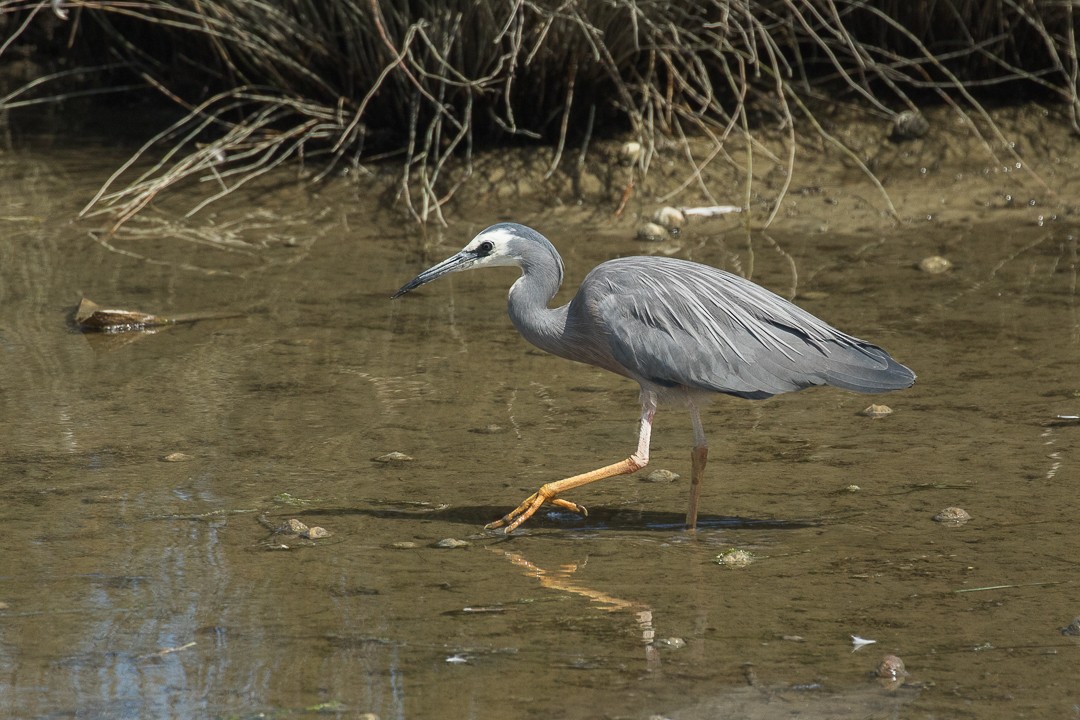White-faced Heron
A species of Typical Egrets Scientific name : Egretta novaehollandiae Genus : Typical Egrets
White-faced Heron, A species of Typical Egrets
Botanical name: Egretta novaehollandiae
Genus: Typical Egrets
Content
Description People often ask General Info
 Photo By Francesco Veronesi , used under CC-BY-SA-2.0 /Cropped and compressed from original
Photo By Francesco Veronesi , used under CC-BY-SA-2.0 /Cropped and compressed from original Description
The adult white-faced heron is medium-sized for the family and mostly pale blue-grey. The forehead, crown, chin and upper throat are white. The crown pattern is variable, with the white occasionally spreading down the neck; the variability makes identification of individuals possible. The iris may be grey, green, dull yellow or cinnamon. The regions between the eye and bill on the side of the head (lores) are black. The beak is black and often pale grey at the base. During the breeding season pinkish-brown or bronze nuptial plumes appear on the foreneck and breast, with blue-grey plumes appearing on the back. The adult typically weighs 550 g (1.21 lb) and ranges from 60 to 70 cm (24–28 in) in height. Immature birds are paler grey with only the throat white, and often have a reddish colour on the underparts. Chicks are typically covered with grey down. 
Size
60 - 70 cm
Life Expectancy
15-20 years
Nest Placement
Tree
Feeding Habits
White-faced Heron consume a mixed diet including fish, frogs, small reptiles, and insects. They exhibit diverse foraging behaviors like standing still, slow wading, and wing flicking to catch prey. Their rhythmic neck movement is a distinctive hunting adaptation.
Habitat
The white-faced Heron exhibits ecological adaptability, occupying a mix of aquatic and terrestrial environments. Its habitat spans from inland wetlands with shallow fresh or brackish waters to coastal regions such as estuaries, mangroves, tidal mudflats, reefs, and rocky shores. Additionally, the white-faced Heron may inhabit man-made structures like farm dams, golf courses, city parks, and rice fields. Presence is also noted in grasslands, pastures, and even urban settings. The white-faced Heron can be found up to elevations of 1500 meters, though it generally breeds below 1000 meters.
Dite type
Piscivorous
People often ask
General Info
Feeding Habits
Bird food type
Behavior
The white-faced heron typically perches on fence-posts, trees, telephone poles and house roofs. Its flight is slow and bouncing. 
Distribution Area
The white-faced heron is found throughout most of Australasia, including New Guinea, the islands of Torres Strait, Indonesia, New Caledonia, New Zealand, the islands of the Subantarctic, and all but the driest areas of Australia. The species is now resident on Christmas Island but has not yet been recorded breeding there. It is also commonly found on Lombok, Flores and Sumbawa, and has appeared as a vagrant in China, the Cocos Islands and the Solomon Islands. 
Scientific Classification
Phylum
Chordates Class
Birds Order
Pelicans and Relatives Family
Herons Genus
Typical Egrets Species
White-faced Heron